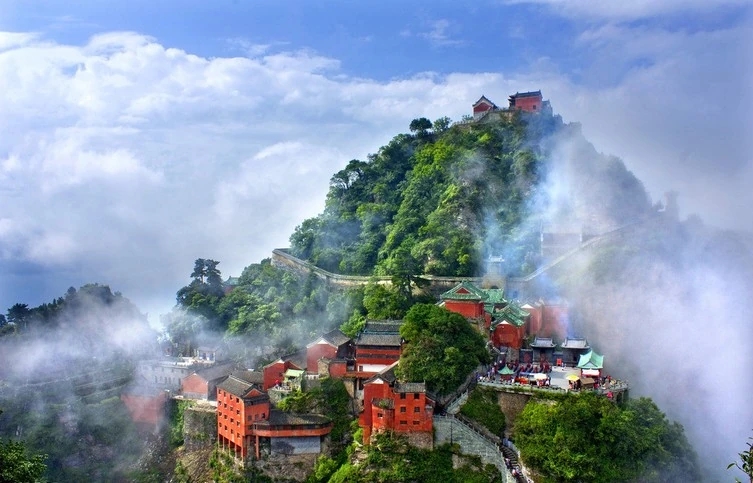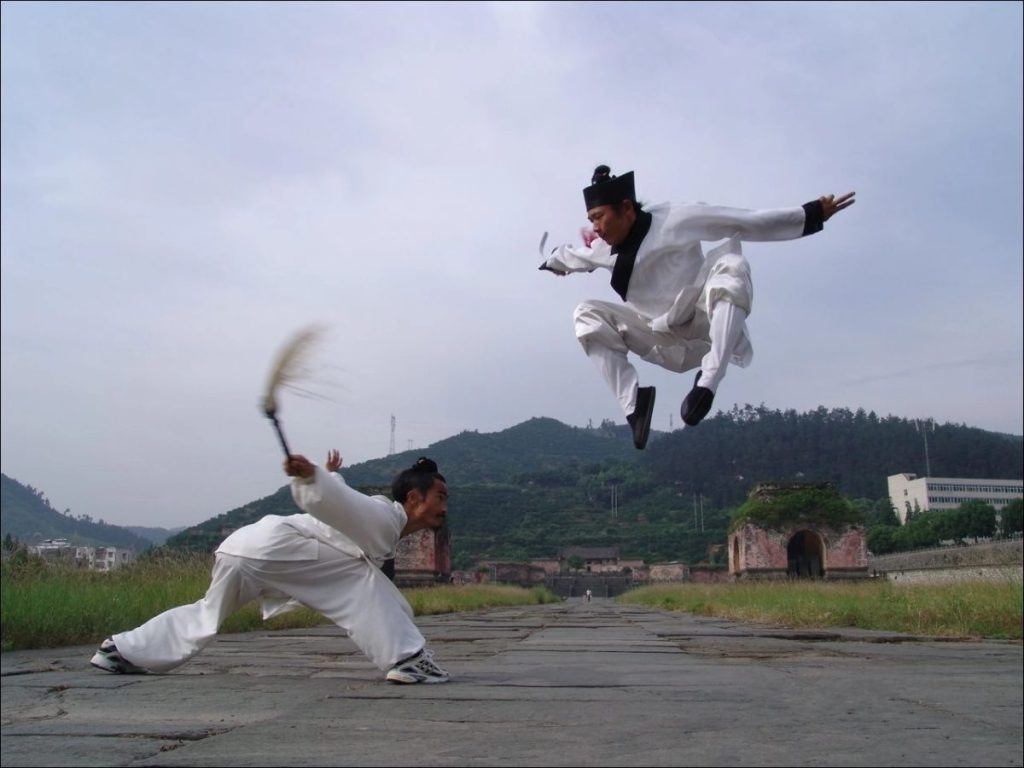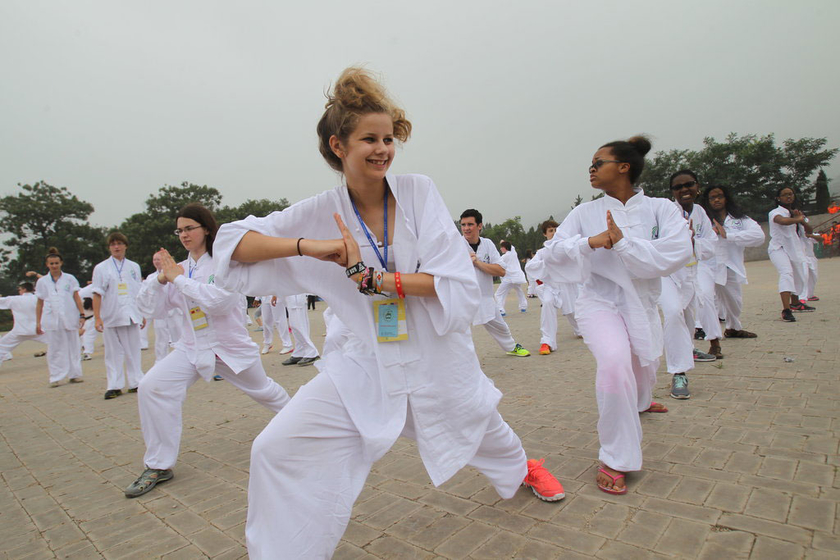Wudang Mountain, not only a sacred place of Chinese Taoism, but also a World Heritage Site and designated as a national 5A tourist attraction, is located in the Danjiangkou area of Shiyan City, Hubei Province, China, and is a magical place that combines Taoist culture, magnificent nature and ancient architectural wonders. It is a magical place that combines Taoist culture with magnificent nature and ancient architectural wonders. It enjoys the reputation of “a place of unparalleled beauty and the first immortal mountain in the world”.
Double wonders of nature and architecture

Tianzhu Peak and Golden Dome
Tianzhu Peak, the main peak of Wudang Mountain, is 1,612 meters high, shaped like a giant pillar between heaven and earth. The Golden Hall on the peak is a building cast in copper and gilded with gold, representing the ultimate level of metal craftsmanship in ancient China. You can choose to climb on foot or take the cable car, all the way to the spectacular “72 peaks facing Tianzhu Peak”.
Zixiao Palace and Nanyan Palace
Zixiao Palace is the best-preserved royal Taoist complex on Wudang Mountain, with its double-layered flying eaves and exquisite murals showing the charm of Ming Dynasty architecture. The South Rock Palace is famous for its “Hanging Temple”, the dragon head incense burner hanging on the cliff, which has become a holy place in the hearts of Taoist believers.
Prince’s Slope and Easy Valley
Prince’s Slope attracts many photographers with its red walls, green tiles and the unique Nine Curves Yellow River Wall. The streams and rhesus monkeys in the Easy Valley add a bit of wildness and vividness to the area.
Natural Wonders
The four seasons of Wudang Mountain have their own characteristics. In spring, you can enjoy the blooming of azaleas; in summer, it is a good place to escape from the summer heat; in autumn, the leaves are full of red, and in winter, the snow scene is picturesque. In addition, natural phenomena such as the “Thunder and Fire Refining Hall” and “Tianzhu Xiaoqing” add a bit of mystery to Wudang Mountain.
In-depth experience of Taoist culture

History and Inheritance of Taoism
Since the Tang Dynasty, Wudang Mountain has been an important place for Taoist practice, and in the Ming Dynasty it was honored as the “Imperial Family Temple”. The architectural layout reflects the philosophy of “unity of heaven and man”, such as the axis design of the Purple Heaven Palace, which symbolizes the status of the North Star.
Wudang Kung Fu and Tai Chi
Wudang Kung Fu is known for its “softness with strength” and Tai Chi Chuan originated here. You can join the morning Tai Chi practice or watch the Taoist priests perform Tai Chi at the Zixiao Palace. Zhang Sanfeng is said to have learned his internal martial arts here, and today more than 300 million people worldwide practice Taijiquan.
World Heritage
The ancient architectural complex of Wudang Mountain was inscribed on the World Heritage List in 1994. There are 53 ancient buildings, including 9 palaces and 8 temples, showcasing the essence of architectural art from the Yuan, Ming and Qing dynasties.
Taoist Mountain Cuisine
Taoist Lenten Cuisine
Wudang Mountain’s fasting dishes are mainly made of mushrooms and bean products, such as “Xuanmen Button Pork” (vegetarian food imitating meat) and “Taiji Kudzu Soup”, both of which reflect the philosophy of “Taoism follows nature”. You can enjoy these traditional vegetarian dishes at the Zixiao Palace or the Taihe Palace.
Fangxian Yellow Wine
This 1,000-year-old imperial wine, fermented with glutinous rice and wild plants, has a moderately sweet and sour taste and is known as “liquid bread”. It has a unique flavor when paired with local preserved meat or wild vegetables.
Mountain Treasures and Han River Fish Banquet
Wild vegetables from the Wudang Mountains (such as toon and bamboo shoots) and fish feasts from the Han River (such as bleak and Jianhe fish) are not to be missed, as they are not only natural and pollution-free, but also have health benefits.
Specialty Snacks
The “Three Harmonies Soup” (beef, dumplings and sweet potato flour) and the “Wudang Pot Sticker Bun” show the perfect fusion of Hubei and Sichuan flavors.
In-depth experience and practical information

Pilgrimage and Prayer
Every year, Wudang Mountain hosts grand temple festivals on March 3 and September 9 of the lunar calendar. Believers hike along the ancient sacred path to the Golden Peak, participate in Taoist ceremonies, and experience the beautiful meaning of “happiness, longevity, and well-being”.
Wellness Vacation
Wudang Mountain has launched the “Wudang 369” tourism brand, which includes programs such as meditation, Taoist medical consultation, and valley retreat, ideal for visitors seeking physical and mental balance.
International Exchange
There are “foreign disciples” from 16 countries practicing martial arts all year round, and the Taiji morning class outside the Zixiao Palace has become a window for cross-cultural exchange.
Practical Information
Tickets: The basic attraction ticket price is 164 RMB, the sightseeing bus ticket price is 70 RMB, and additional tickets are required for the Golden Dome and the Purple Heavenly Palace.
Transportation: It takes about an hour’s drive from Shiyan Airport to the scenic spot; high-speed railways can directly reach Wudangshan West Station.
Best Season: All seasons are suitable, but spring and fall have the most pleasant climate for hiking.
Accommodation: There are star hotels at the foot of the mountain to choose from, while the inns at the top of the mountain allow you to experience the marvelous feeling of “sleeping on a fairy mountain at night”.
